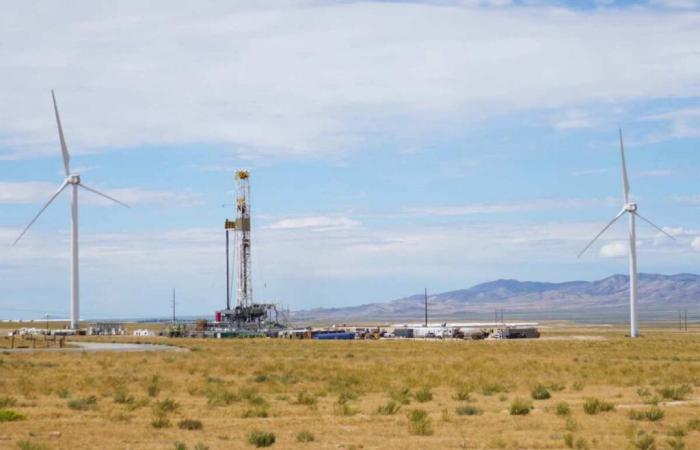This is not a classic geothermal system in volcanic regions. It is an improved system that injects cold water more than 4,000 meters deep, where it is heated in rocks up to 200°C and generates steam that powers electric turbines.
Oil drilling technology applied to carbon-free energy
In rural southwest Utah, a valley has become a renewable energy hub. Dozens of large white wind turbines can be seen spinning in the sky, and a sea of solar panels glowing in the distance. However, the most recent project installed in this region is largely hidden underground.
Fervo Energy’s Cape Station looks, in appearance, like an ordinary oil drilling platform, with a thin metal tower rising above the landscape. But this $2 billion geothermal project does not seek to extract gas, but underground heat. Tim Latimer, CEO of Fervo Energy, believes this natural heat could be the key to producing carbon-free energy in large quantities.
« With these three drilling platforms alone, we will produce 100 megawatts of electricity. From theelectricity 24 hours a day, 7 days a week said Mr. Latimer from a metal platform 12 meters above the ground, as he oversaw the project under construction. It is one of 24 platforms installed by Fervo at Cape Station to harness the earth’s heat to generate electricity.
Improved geothermal energy: a new frontier
Unlike traditional geothermal systems, such as those found in volcanic sites like Iceland or The Geysers project in California, this project uses an enhanced geothermal system. In this type of system, cold water is injected into a well more than 4,000 meters deep that curves horizontally at its end, like a hockey stick. Water flows through cracks in the rocks which reach temperatures of over 200°C, heats up and returns to the surface through a second well parallel to the first. This closed cycle generates steam that drives turbines to produce electricity, and the water is then reintroduced underground.
This innovative system was made possible by Utah’s FORGE federal research project, which invested $300 million in developing this technology in the same valley where Fervo operates. Technological advances, such as higher performance bits coated with synthetic diamonds, have allowed Fervo to reduce drilling time by 80% compared to just a few years ago.
Fervo has already demonstrated the viability of this system in a pilot project in Nevada, where it began supplying electricity to a Google data center. Additionally, initial tests at Cape Station have shown that this new project can produce electricity at a rate three times higher than the pilot project in Nevada.
An important step towards clean energy
During the summer of 2023, enhanced geothermal energy took another step toward becoming a domestic energy source. Fervo has signed a historic agreement with Southern California Edison, one of the largest electricity companies in the United States, with 15 million customers. Starting in 2026, the Fervo plant will send the first 70 megawatts of geothermal energy to the grid. When the project is fully operational in 2028, it will produce 320 megawatts, enough to power 350,000 homes, and its total capacity will be 400 megawatts.
Carbon-free power mandates drive demand
In 2018, California established a mandate requiring 100% of its electricity to come from renewable sources by 2045. These types of policies are creating high demand for new sources of clean energy, and geothermal is starting to position itself as a key option. Additionally, the U.S. Department of Energy has set a goal of increasing the nation’s geothermal capacity nearly 25-fold by 2050, which would power more than 65 million homes.
Although geothermal energy is currently more expensive per megawatt hour than wind or solar power, these sources require large batteries to maintain continuous supply. Geothermal energy, on the other hand, has the potential to produce energy continuously and adapt to the needs of the electricity grid, making it a more stable renewable energy source.
The future of geothermal energy
The agreement with Southern California Edison sends a clear message to the energy market about the viability of geothermal energy. While it is not yet certain whether geothermal energy can become a reliable large-scale energy source, its potential gives rise to cautious optimism. If Fervo’s Utah project is successful, other companies could follow suit and build additional geothermal power plants across the country in the coming years.
This type of renewable energy has strong potential for rapid expansion, in part because it leverages the technologies and expertise of the fossil fuel industry. Fervo, for example, is based in Houston, a city known as the heart of the oil industry, and many of its employees come from that sector.
The transition to geothermal energy not only helps reduce carbon emissions, but also provides an opportunity for fossil fuel industry workers seeking new jobs in the renewable energy sector. Fervo CEO Tim Latimer believes this Utah project is just the beginning of much larger expansion in the decades to come.
Enhanced geothermal technology not only represents a promising source of clean, consistent energy, but it also offers a career transition solution for thousands of oil industry workers, contributing to a more sustainable future for all.






